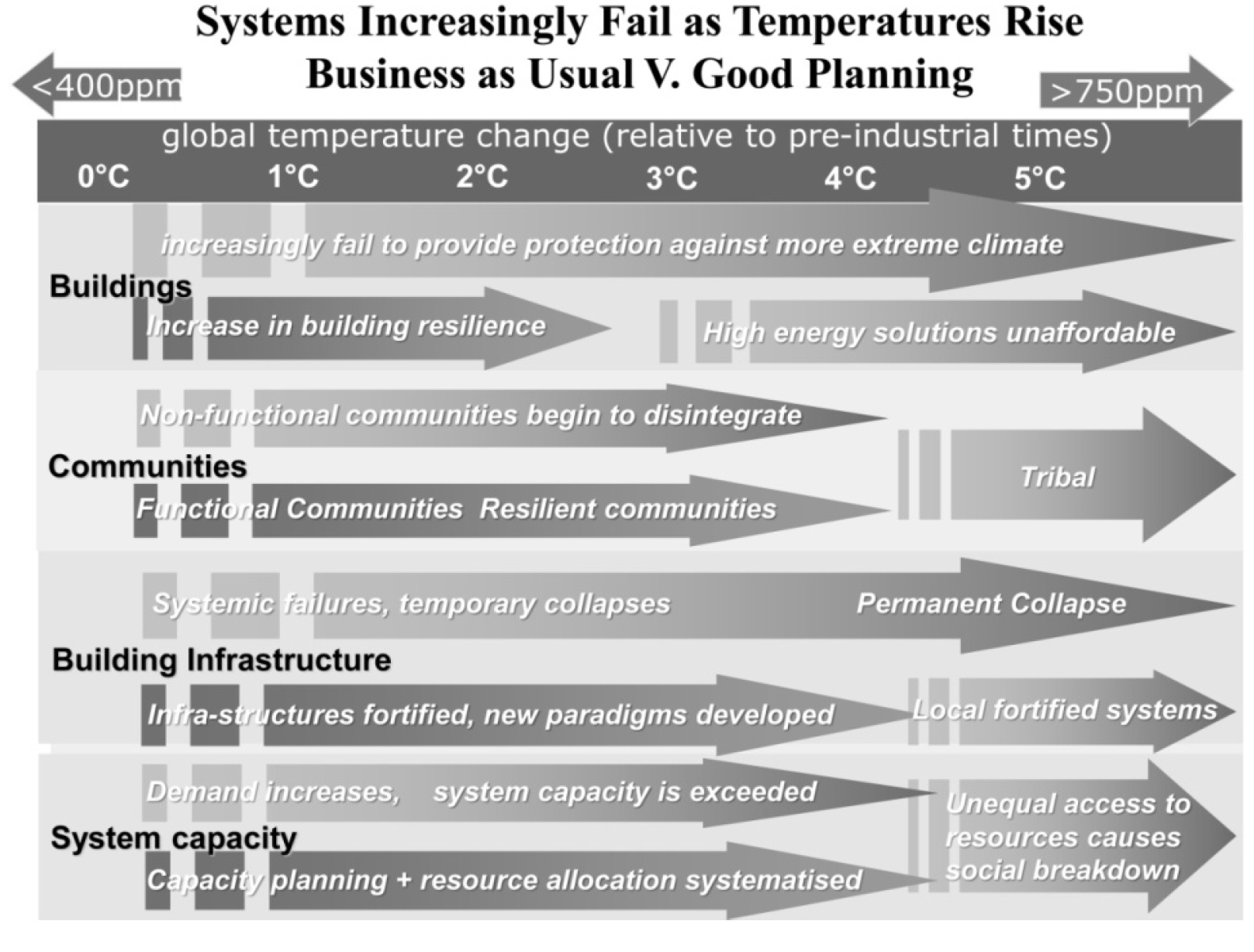Transitioning to eco-cities: Reducing carbon emissions while improving urban welfare
Author: Susan Roaf
Introduction
We live in a world where rapid change and unmanaged growth is driving the collapse of established systems, be they top-down macroeconomic failures of the economies such as those of Greece and Spain in 2012, the bottom-up collapse of the housing markets in the United States in 2007–2010, or the escalating failure of infrastructures and buildings to provide adequate shelter during extreme weather events (see Figure 1). While seeking to avoid such collapses, we must understand where economic weaknesses and related breaking points exist and how to measure them. In rapidly evolving systems, we must efficiently draw on experience to grow in successful directions. This chapter tackles the challenges of creating such measures and explores the form they might take, using case studies from Arizona and the city of Dundee in Scotland.
Figure 1: The Warming of the Climate Will Exacerbate the Nature and Rate of Collapse of the Whole Gamut of Our Social and Physical Systems within the Built Environment. Strengthening of These Systems Is Essential to Improve Their Adaptive Capacities and Resilience to Collapse
Source: Roaf et al. 2009.
The chapter is divided into four parts. The first deals with concepts of resilience and adaptive capacity of individuals and populations within that built environment. Part two presents a case study of the failure of the Arizonan housing market in 2007–2010. This details the problem of asymmetric information, the ignorance by the majority of the potentially catastrophic impacts of rising energy, transport and water prices on their own household budgets, and raises the question of how this was allowed to happen in a so-called “responsible” society. Part three introduces the second case study of the city of Dundee in Scotland and a consideration of the role that solar technologies might play in alleviating fuel poverty in that city. The fourth and final part discusses the development of standardised metrics and indicators for describing the adaptive economic capacity of a population and testing the sensitivities of a group to a range of hazards that may threaten to cause the socioeconomic systems within which they operate to collapse. Such metrics and indicators would provide decision makers with the critical ability of testing policies and strategies against the capacity of the system to absorb stress and its breaking points under a range of different conditions. While so doing, such metrics can be used to inform successful adaptation strategies for different populations.
The conclusions clearly point to the social and economic benefits of moving towards facilitating the adoption of wide-scale use of solar energy for domestic populations to reduce economic stress upon them and prevent the collapse of regional housing markets and with them their attendant communities....
This paper was entered into a competition launched by --BRE Group and UBM called to investigate the link between buildings and the wellbeing of those who occupy them.
Related articles on Designing Buildings
- A measure of net well-being that incorporates the effect of housing environmental impacts.
- Adapting 1965-1980 semi-detached dwellings in the UK to reduce summer overheating and the effect of the 2010 Building Regulations.
- Anatomy of low carbon retrofits: evidence from owner-occupied superhomes.
- COP26: A BSRIA summary.
- Energy companies obligation ECO.
- Fuel poverty.
- Green deal scrapped.
- Heat Energy: The Nation’s Forgotten Crisis.
- Housing contribution to regeneration.
- The cold man of europe 2015.
- The real cost of poor housing.
- Well-being and regeneration: Reflections from Carpenters Estate.
- Wellbeing.
Featured articles and news
A change to adoptive architecture
Effects of global weather warming on architectural detailing, material choice and human interaction.
How big is the problem and what can we do to mitigate the effects?
Overheating guidance and tools for building designers
A number of cool guides to help with the heat.
The UK's Modern Industrial Strategy: A 10 year plan
Previous consultation criticism, current key elements and general support with some persisting reservations.
Building Safety Regulator reforms
New roles, new staff and a new fast track service pave the way for a single construction regulator.
Architectural Technologist CPDs and Communications
CIAT CPD… and how you can do it!
Cooling centres and cool spaces
Managing extreme heat in cities by directing the public to places for heat stress relief and water sources.
Winter gardens: A brief history and warm variations
Extending the season with glass in different forms and terms.
Restoring Great Yarmouth's Winter Gardens
Transforming one of the least sustainable constructions imaginable.
Construction Skills Mission Board launch sector drive
Newly formed government and industry collaboration set strategy for recruiting an additional 100,000 construction workers a year.
New Architects Code comes into effect in September 2025
ARB Architects Code of Conduct and Practice available with ongoing consultation regarding guidance.
Welsh Skills Body (Medr) launches ambitious plan
The new skills body brings together funding and regulation of tertiary education and research for the devolved nation.
Paul Gandy FCIOB announced as next CIOB President
Former Tilbury Douglas CEO takes helm.
UK Infrastructure: A 10 Year Strategy. In brief with reactions
With the National Infrastructure and Service Transformation Authority (NISTA).
Ebenezer Howard: inventor of the garden city. Book review.
Airtightness Topic Guide BSRIA TG 27/2025
Explaining the basics of airtightness, what it is, why it's important, when it's required and how it's carried out.
























